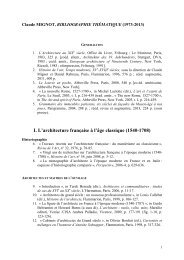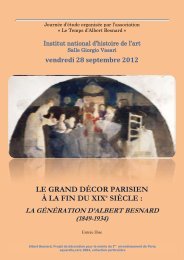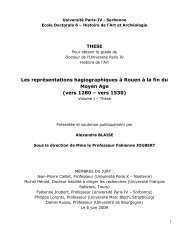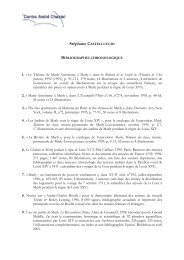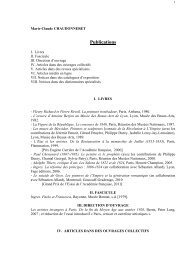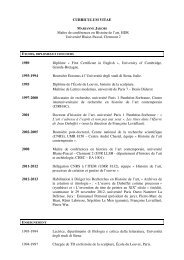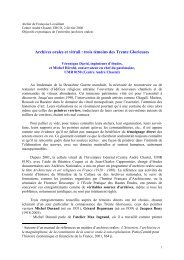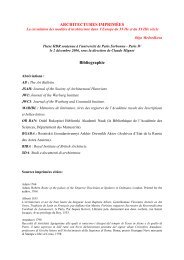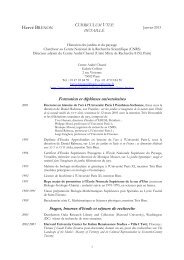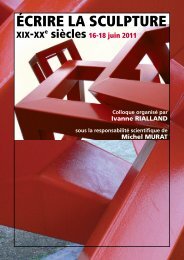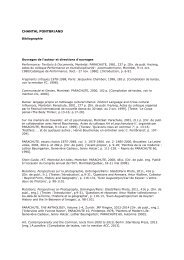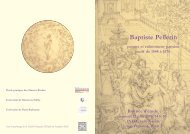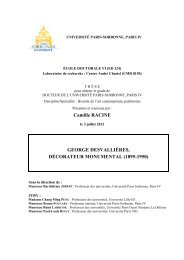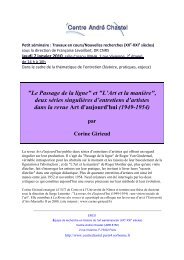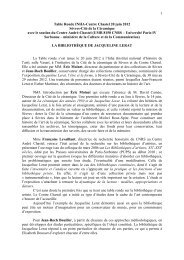Corpus Vitrearum - Centre André Chastel
Corpus Vitrearum - Centre André Chastel
Corpus Vitrearum - Centre André Chastel
Create successful ePaper yourself
Turn your PDF publications into a flip-book with our unique Google optimized e-Paper software.
mardi 4 juilletRésumés des communicationsJoost Caen et Bert De MunckTechnical Prescriptions for the Production ofStained and Leaded Glass in Guilds’ Ordinancesand Recipe Books in the Southern Netherlandsin the 15th, 16th, 17th and 18thCenturyFig. 1 Gent, Stadsarchief : Ordinance of 6 April 1541, Book of Membership(1338-1733), f° 17r°. One of the first references to enamel paint use in theNetherlands.Historical research into crafts and guilds is all toooften restricted to the confines of archival institutions.Rarely are research findings compared withpreserved artefacts. The present research projectstrives to take a first step towards filling this void bytaking a combined approach, involving the historyof crafts and guilds on the one hand and materialtechnicalresearch into the methods applied bycraftsmen on the other. More in particular, we focuson the glaziers’ and/or the stained-glass crafts.The confrontation of material-technical aspects of(stained) glass and rules and regulations issued bythe guild is relevant to both the history of consumerismand material culture and to the historyof the crafts and their attitude towards technologicalinnovation on the other. As far as materialculture is concerned,long gone are the days that onlythe art-historical value of archaeological and historicalobjects was considered important.The fact thateveryday artefacts also have a historical and socioculturalsignificance follows from a perfectly datablehistorical evolution. By studying the glazing of homesand glass produced by anonymous craftsmen, onecan gain insight into a development whereby prestigiousluxury products gradually had to make way forcheap, fashion-sensitive and mass-produced items.This transition, which unfolded between 1500 and1800, coincided with a changing attitude on the partof the guilds and craftsmen towards established andinnovative techniques. From the perspective of this‘consumption revolution’, the strategies of thenumerous anonymous glassmakers and their corporatistinstitutions may well be more relevant thanthe household names in the history of art.Over the past few years,we have studied guilds’ ordinances,tracts, recipe books and other documentsfrom across the former Southern Netherlands andidentified a large number of technical prescriptionsconcerning the art and craft of stained and leadedglass. The ordinances provide a limited amount ofinformation on glass painting and firing. However, wefound many regulations concerning the quality ofglass and lead, and pertaining to the leading andsoldering as well as the placement of panels.Other documents provide information about glasspaintproduction, glass painting and glass firing. Mostof the 17th and 18th century treatises are wellknown and often quoted. Among these works arethe Dutch translations of A. Neri’s L’ Arte Vetraria(1612) by S.Witgeest (Het nieuw Toneel der Konsten,1679) and of A. Félibien’s Les principes de l’architecture(1676) by F. Le Comte (Het Konst-Cabinet der Bouw-Schilder-Beeldhouw-en Graveerkunde, 1761). Otherbooks were never translated into Dutch, but werenevertheless widely distributed in the SouthernNetherlands, including J. Kunckel’s Ars VitrariaExperimentalis (1689), Baron D’Holbach’s L’artde la verrerie (1752) and P. Le Vieil’s L’art de lapeinture sur verre et de la vitrerie (1774). A veryimportant and early source is a 16th centurySouthern Netherlandish recipe book from thePlantin-Moretus Museum in Antwerp. The manu-20



